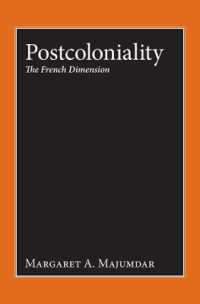- ホーム
- > 洋書
- > 英文書
- > Science / Mathematics
Full Description
Although there are many texts that provide quality information for the identification of fungi, researchers and technologists rarely have time to read the text. Most are rushed for time and seek morphological information that helps guide them to the identification of fungi.
The Atlas of Clinically Important Fungi provides readers with an alphabetical list of fungi as well as listing the division of fungi by both sporulation and morphology. The characteristic traits for a particular fungus are displayed through a series of images, with the fungi appearing as they did in the author's lab on the day(s) that testing was performed. For this reason, numerous (6-20) color photographs are included so that technologists will have sufficient reference photos for identifying the various morphologies of a single organism. Organism photographs begin with the macroscopic colony views followed by the microscopic views. Also included for some microorganisms, are clinical pathology photographs demonstrating how the organism appears in human tissues.
A collection of literature citations are also provided to enable further reading.
This user-friendly fungi atlas provides a resource for those seeking information in the field of medical mycology, specifically with regards to identifying an organism using the parameters of culture morphology.
Contents
Preface xi
Acknowledgments xiii
Abbreviations xv
Part I Divisions of the Fungi 1
1 Morphological Growth Index 3
1.1 Filamentous Bacteria 3
1.2 Yeasts and Yeast-like Organisms 3
1.3 Yeast/Yeast-like Organisms That Produce Hyphae 4
1.4 Thermally Dimorphic Fungi 4
1.5 Thermally Monomorphic Molds 4
1.6 Dematiaceous (Brown or Black Colored Fungi) 6
1.7 Other Fungi for Which No Photographs are Available 8
2 Division of Fungi by Type of Sporulation 9
2.1 Annelloconidia 9
2.2 Arthroconidia 9
2.3 Arthroconidia and Blastoconidia 9
2.4 Arthroconidia; Spherule in Tissue 9
2.5 Basidiospores 9
2.6 Phialoconidia 9
2.7 Produce Only Macroconidia 10
2.8 Macroconidia and Microconidia 10
2.9 Perithecium and Ascospores 10
2.10 Sporangia or Sporangiospores 10
2.11 Sporangia with Rhizoids 11
2.12 Produce Only Microconidia 11
2.13 Microconidia and Chlamydoconidia 11
2.14 Microconidia and Arthroconidia 11
2.15 Microconidia and Cleistothecium 11
2.16 Yeast Only 12
2.17 Yeast and Hyphae and Phialides 12
2.18 Yeast and Pseudohyphae 12
2.19 Yeast and Conidia 12
3 Division of Fungi, Yeast, and Bacteria by Morphological Group 13
3.1 Actinomycetes, Yeast, and Yeast-like Organisms 13
3.2 Dimorphic Organisms 13
3.3 Dermatophytes 13
3.4 Zygomycetes (Aseptate) 14
3.5 Hyaline Molds (Septate) 14
3.6 Dematiaceous Fungi (Septate) 14
Part II Descriptions and Photographs of Microorganisms 17
4 Actinomycetes, Yeast (Thermally Monomorphic), and Yeast-like Organisms 19
4.1 Microorganisms with Fungal-like Morphology Occurring in Fungal Cultures 19
4.2 Yeast and Yeast-like Fungi 19
4.3 Candida spp 34
4.4 Prototheca spp 36
4.5 Arthrographis kalrae 39
4.6 Cryptococcus neoformans 44
4.7 Geotrichum candidum 47
4.8 Malassezia spp 56
4.9 Trichosporon spp 58
5 Yeast (Thermally Dimorphic) 63
5.1 Blastomyces dermatitidis 63
5.2 Coccidioides immitis 69
5.3 Histoplasma capsulatum 73
5.4 Sporothrix schenckii 83
6 Zygomycetes (Aseptate) 89
6.1 Lictheimia (Absidia) corymbifera 89
6.2 Conidiobolus lamprauges, coronatus, incongruus 95
6.3 Cunninghamella bertholletiae 102
6.4 Mucor spp 106
6.5 Rhizomucor spp 116
6.6 Rhizopus spp 121
6.7 Syncephalastrum racemosum 130
7 Dermatophytes 135
7.1 Microsporum spp 135
7.2 Trichophyton spp 145
7.3 Epidermophyton floccosum 161
8 Hyaline Molds (Septate) 167
8.1 Aspergillus spp 167
8.2 Beauveria bassiana 182
8.3 Emmonsia spp 187
8.4 Fusarium spp 193
8.5 Gliocladium 215
8.6 Malbranchea spp 220
8.7 Paecilomyces spp 223
8.8 Penicillium spp 228
8.9 Ramichloridium spp 232
8.10 Schizophyllum commune 238
8.11 Scopulariopsis brevicaulis 244
8.12 Scopulariopsis brumptii 250
8.13 Sepedonium spp 254
8.14 Sporotrichum pruinosum 258
8.15 Trichoderma spp 264
8.16 Trichothecium roseum 271
8.17 Chrysosporium tropicum 274
9 Dematiaceous Fungi (Septate) 281
9.1 Acremonium spp 281
9.2 Alternaria spp 289
9.3 Aureobasidium pullulans 292
9.4 Bipolaris spicifera, Curvularia hawaiiensis (B. hawaiensis), and C. australiensis (B. australiensis) 297
9.5 Chaetomium spp 305
9.6 Cladophialophora (Xylohypha) bantiana 308
9.7 Cladophialophora boppi 311
9.8 Cladophialophora carrionii 314
9.9 Cladosporium sphaerospermum 317
9.10 Cladosporium spp 320
9.11 Curvularia spp 327
9.12 Epicoccum spp 332
9.13 Exserohilum spp 337
9.14 Fonsecaea 343
9.15 Hormonema dematioides 351
9.16 Hortaea (Phaeoannellomyces, Exophiala) werneckii 355
9.17 Madurella spp 361
9.18 Neoscytalidium spp 369
9.19 Nigrospora spp 376
9.20 Ochroconis (Dactylaria) spp 380
9.21 Phaeoacremonium parasiticum 385
9.22 Phialemonium spp 390
9.23 Phialophora spp 395
9.24 Pithomyces sp 401
9.25 Pseudallescheria boydii 407
9.26 Scedosporium 412
9.27 Stachybotrys chartarum 417
9.28 Stemphylium sp 422
9.29 Ulocladium sp 425
9.30 Phoma sp 429
9.31 Rhinocladiella basitona 435
9.32 Exophiala dermatitidis (Wangella dermatitidis) 441
9.33 Exophiala jeanselmei 447
Additional Reading 453
Index 000







